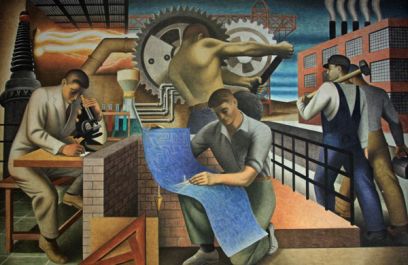Builders of the American republic in the decades either side of 1800 grasped and employed new philosophical and ideological tools for its construction. The revolutionary idea of inherent political equality—“all men are created equal” with “inalienable rights”—however limited its reality then seems looking back from now, was the Next Big Thing of the day. Also critical were economic analyses originating with Adam Smith and his British colleagues. “Free market” arguments asserted that self-interested actors uncontrolled by authorities combine to create the greatest good for the greatest number.
John Lauritz Larson, in a recent presidential address to the Society for Historians of the Early American Republic, notes a couple of important similarities between the political theories and the economic theories of America’s revolutionary era. Both sets of ideas demanded that the king’s government get off people’s backs, especially by stopping its interference in commerce. And both sets of ideas asserted, based 18th-century “scientific” analysis, that state rule distorted the God- or Providence- or Nature-given order of things. Men, advocates argued, were naturally equal and self-governing; similarly, markets were naturally productive and self-governing.
Larson goes on to make the point that there was nothing natural about the ascendency of the naturalistic argument for the laissez-faire philosophy. But we live with its seeming naturalness to this day.
Birth of a System
Larson contends that Adam Smith’s “new framework resonated as a scientific discourse alongside . . . the new sciences of nature that lately had been exposing immutable ‘laws’ . . . [explaining the] physical world. In each realm—economy, politics, and the natural world—scientific reasoning promised to disable the tyranny of ancient prerogatives, superstitions, illegitimate customs, and fantastical explanations.” In the economic realm, this new science stated “that restrictions and regulations on the exchange of goods or specie were misguided and futile . . . .” and that “in the end, the private individual—Smith’s primary actor—facilitates the greater good simply by following his self-centered impulses.” The Smithian analysis challenged governmental intervention in and controls on trade, money, and industry, and governmental favoring of some enterprises over others.
Smith’s work suited the American revolutionaries well, Larson writes, because they were claiming, not that the monarchy was injuring their private interests, but that it was trampling on natural political laws and natural human reason. Such Smithian ideas thrived long beyond the Revolution. Their interpreters, Larson shows, asserted that they were simply reporting facts of nature revealed by science.
Smithian ideas about natural political laws and natural human reason thrived long beyond the Revolution.
Many early Americans resisted such claims. Hamilton and the Federalists’ projects for national improvement—roads, canals, and such—entailed unnatural state intervention, albeit on behalf of industry. More profoundly, defenders of traditional, colonial-era prerogatives such as local price and wage controls, the priority of hunting and fishing rights over private property, and claims for charity by the dispossessed, fought this new worldview. For the most part, they lost. (See this earlier post.) Ironically, the free market ideology succeeded much better here than in its European home.
In the antebellum era, the promise of the Smithian model that workers’ wages would rise and the dictum that free trade lifted all boats fell short. Instead, poverty and inequality rose. Americans’ heights actually shrunk even as their markets grew. The ideological response to this disappointment, Larson argues, was to increasingly explain poverty as a moral failure of the poor, not as a failure of the ideas. He then describes the final ideological step of that era: Although an historical and theological contradiction, some religious leaders blessed Smithian science. “‘Conditions of being’ [i.e., scientific laws] laid down ‘by our Creator’” dictated that people should get nothing unless they have earned it. Thus, most of those who had nothing deserved nothing because of their vice and sloth, not because of the market.
Later
How could these intellectual musings make any difference to average early-Republic Americans, most of whom were hard-scrabble farmers, farm wives, and farm hands?
Free market ideology spread out from the intellectual centers over the years. Its views fit well with Americans’ Jeffersonian emphasis on egalitarian self-reliance and with their hostility to government. And it fit well with the widespread ownership of property (mainly farms) among white men. The combination of egalitarianism, anti-statism, and small property-holding fueled, for example, Jacksonian-era resistance to a national bank. At least as important, politicians and judges built the emerging economic system, along with its underlying assumptions about the free market’s natural lawfulness, into American law. Businesses and, notably, autonomous corporations gained more freedom of action over the nineteenth century. Courts banned efforts to constrain those actions (as in worker-protection laws, described by critics as violations of free actors’ right to contract), long before the “law and economics” philosophy, so influential today, explicitly emerged in the courts.
The conquest of the Smithian model was not smooth and complete. For example, the Lincoln administration introduced many Hamiltonian government policies, the two Roosevelt administrations created huge programs by which the government steers the economy and oversees business, and the Nixon administration introduced environmental regulations. But at the foundation of the American political economy even today, Larson suggests, are institutions built with ideas from the Smithian analysis of human nature.








